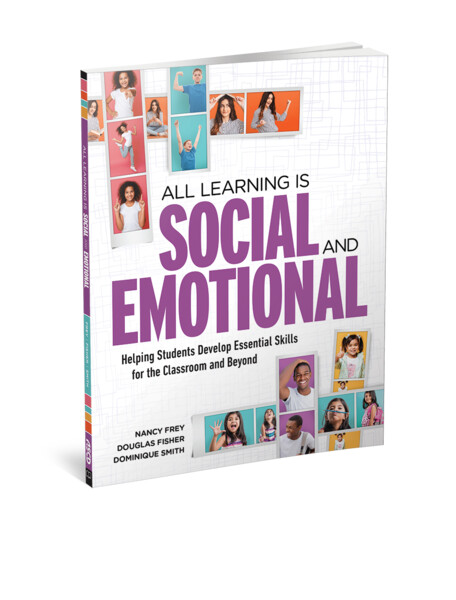Dominique Smith is the principal of Health Sciences High and Middle College in San Diego. He is also a social worker, mentor, and national presenter and trainer on restorative practices. Smith is the coauthor of many books, including All Learning Is Social and Emotional: Helping Students Develop Essential Skills for the Classroom and Beyond (ASCD, 2019), Building Equity: Policies and Practices to Empower All Learners (ASCD, 2017), and Better Than Carrots or Sticks: Restorative Practices for Positive Classroom Management (ASCD, 2015). We recently talked to him about his disciplinary philosophy.
How has student behavior changed in the past couple of years?
Yeah, that’s been the big conversation—and we can address it. But I like to hit the pause button and ask, What’s the adult behavior that’s changed? I think some of us haven’t fully recovered from the pandemic. Adults feel like they’re not making as strong of an impact. As a school leader, some of the tools and strategies that were successful for me a couple of years ago aren’t working now. I get frustrated a little faster. I don’t listen as clearly or hear my students as clearly because I’m still catching up. I’m still rebuilding my agency. So, we have to make sure we look at our own behavior. Am I my best self today? Because if I’m not, it’s easy to shift the blame.
I’m not downplaying student behavior problems. After so much time spent at home during school closures, we’re seeing that some of our students like to be isolated. In classrooms, that looks like non-engagement—for example, lower participation and a dependence on electronics. They’re also more comfortable questioning adults. Why can’t I do that? We are so accustomed to saying, “Don’t do that,” “Stop that,” “You can’t do that”—and to students replying “OK.” Now, they ask why. Why can’t I have my cell phone out? Why can’t I talk to my partner? Why can’t I walk out of class? Give me a reason why. And that doesn’t make us feel good. As teachers and leaders, we’re not accustomed to the back-and-forth conversation. When a student doesn’t have a compliant response, we often get into a power struggle.
It’s causing us a lot of frustration. We’re not skilled in that, which is something I’ve been trying to work on with the team here at my school. How do you have a positive back and forth with a student? Because I do want to hear why they’re saying they don’t want to learn. Is it my teaching? Is it that their prior knowledge isn’t there? Or is the content just not relatable or relevant?
Courtesy of Health Sciences High and Middle College
You’ve been a longtime advocate for restorative practices. Why do you think these practices are important right now?
I’m glad you bring this up because I’m seeing some thought leaders and principal mentors challenge restorative practice, saying it doesn’t work. But I’ve seen the meta-analysis that states that suspensions are terrible for kids. That suspensions only make them fall farther behind in their learning. I have never said to get rid of natural consequences or accountability. But we have to adjust to make sure our response is right for the individual. How do they actually learn? How do we move forward? How do we repair harm? That’s why I think restorative practice is so powerful. A black-and-white approach to behavior doesn’t work. We need to differentiate discipline just like we differentiate academic content.
A black-and-white approach to behavior doesn’t work. We need to differentiate discipline just like we differentiate academic content.
What would you say to teachers and parents who feel like restorative justice isn’t doing enough to hold students accountable?
I say, as a parent, what does accountability really mean? If my son has bad grades or gets in trouble at school and I take his phone away, is that accountability? Or is that him losing his phone for a couple of days? As parents, we take our kids’ phones away all the time when they get in trouble. But guess what? They get their phones back and we take them away again. They’re not learning anything. That’s why I’ve stopped taking the phone away. Instead, my son and I have a real conversation. I say, “This is what’s bothering me. This is why you can’t do what you’re doing.” And my son doesn’t just give me a compliant, “OK, Dad.” He’s actually sitting there with me in conversation.
Now, what happens when a student gets in a fight? Some parents and critics of restorative work believe our schools don’t suspend for fights. I’ve never said that. But let’s look at what the fight was. We have different levels of fights on our campuses. For instance, I just had two students who are friends fight each other because they were talking to each other too much, saying negative things to each other. So, they got really mad and pushed each other and might’ve swung on each other. All of a sudden, I have them separated. And in the meetings when I’m like, “What’s going on?,” they start to break down. They say, “That’s my friend. I shouldn’t have done that. What was I thinking?” I go to the next kid, and they say the exact same thing, “That’s my friend over there, that’s my homie, that’s the guy I care about. I can’t believe I just did that.” My students are taking ownership right then and there. Why do I have to send them away for three days so they can’t be in a learning environment? They want to own it, they say my bad, they say I shouldn’t have done that, that they could do it differently.
I could simply reply, “You guys owned it, great job.” But restorative practice is about communication and reflection. So, I plan a weekly follow-up, with me (the principal) or a counselor or a vice principal or a teacher they have a connection with. Week one: Hey, it’s been a week since you fought, what have you thought about since then, what’s a different strategy for next time? If your friend’s going to say something, what could you do differently? Week two: Hey, did you see how badly it impacted the school when you fought? All those students that were filming you, all those people that said, This happens in our community. Does that make you feel good? Week three: The conversation continues. The follow-through is where restorative practice lives.
Restorative practice gives voice to the individuals who have no voice. It gives power to the powerless.
People think restorative schools don’t give consequences. For accountability purposes, guess what? I have three-, four-, five-week cycles of conversations to see if the student has actually learned from their mistake. The best part of that is the person who’s been hurt, they have a cycle, too. How are you? What do you need? Has anything happened since the incident? Restorative practice gives voice to the individuals who have no voice. It gives power to the powerless. And in some of our suspension models or some of our traditional discipline models, who has the power? The adult.
When are suspensions warranted?
I believe we need some suspensions to keep places safe. But if we suspend a student because it wasn’t a “safe” environment, what did we do in the next couple of days while that student wasn’t at school to make sure that we created a safe environment? And then how did we prepare students (including those who were suspended and harmed), the staff, and other families for when the student is coming back? If we don’t have a system in place for communication, like restorative practice does, students get suspended, they come back, we say, “Don’t do it again or you’ll be suspended again.” And research tells us they’re going to do it again.
Courtesy of Health Sciences High and Middle College
What is the biggest thing a principal can do to support a restorative culture?
One thing we did at our school was implement a standing huddle—with administration, our counselors, and our restorative lead—that holds us accountable. We come together for 10 minutes every morning and talk about behavior. We say, What are the problems in classes and the school, and who is addressing them—and how? And we always ask for grade-level reps to come and talk about the students who are struggling with things like attendance and behavior. We build a plan for peacekeeping conversations. We build a plan for circle times. We build a plan for accountability. And we make sure in our meetings every day that we determine who’s doing the follow-up. Because restorative won’t live unless we do the follow-up.
In September 2018, you wrote “Tear Down Your Behavior Chart!” with Lee Ann Jung, which has been one of the most widely read EL articles of all time. Why do you think it resonates so deeply with educators?
Because we’re human beings. Because as educators, we don’t see the harm in clip charts [a publicly displayed tool that has students raise their name (clip) for “good” behavior and lower it for “bad” behavior] until they harm our own kids. All of a sudden, our kids are coming home, and they’re broken. I wrote that article in 2018, and now my daughter is in a school with a clip chart system.
Courtesy of Health Sciences High and Middle College
Right now?
Right now.
My son was in a rainbow day system, and now my daughter is in the same system. The highest you can reach on the clip chart is “rainbow day.” You know what happens when my little princess doesn’t get a rainbow day? She feels like a failure. She feels like she didn’t do well. She apologizes at home. This “rainbow day” reward has become her biggest consequence.
People started to like that article because it challenged them to think, Maybe this practice isn’t right because shame is real, and nobody wants to be shamed. And that’s what clip charts do—they create shame for our students. They hurt the classroom environment because kids don’t want to connect to each other. They hurt the community environment because parents only see some kids as the “stormy” kids or the bad kids or the red kids.
Can you give educators who are struggling with student behavior one piece of advice?
Look at what is working. Ask yourself, is it your whole classroom that you’re struggling with? If it’s not, if it’s two or three kids, make sure you’re not saying, “My classroom is terrible.” You’re just struggling with two kids. And then start to reframe your thinking with those two kids.
Look at what is working. Ask yourself, is it your whole classroom that you’re struggling with?
We make most of our rule changes for two percent of our population, right? And we get so stuck on that. I always have to ask myself, “Is what is happening in my classroom impacting learning?” If it’s impacting learning, I have to address it. Or does it just bug me?
I don’t downplay that there are significant student behavior challenges in classrooms today. I never want that to come across. I want to make sure the well-being of our teachers is OK and that they’re getting the disciplinary support they need. But I also want to make sure we spotlight that we have a great group of kids in our classrooms, and some are just kind of struggling right now. Let’s not lump everybody into one. Let’s actually break it down and focus on specific behaviors. So: “I’m going to work on this right now for two weeks.” Or, “I’m going to spotlight every moment of success that myself and my student experiences.” Because if we work with a student who is repeatedly getting out of their seat, and they sit in their seat four times in two weeks, that’s progress, right? But if we say, “You haven’t changed,” well, the kid will think, Dang, why did I even sit down four times? Instead of focusing on when they didn’t sit in their seat, we could spotlight the four times they did. “You did amazing. That made me feel great.” All of a sudden you start to experience success. The student says, “Well, thank you for seeing that I’m actually doing it. I’ll do a little bit more.”
Editor’s note: This interview has been edited for space.
All Learning Is Social and Emotional
This comprehensive SEL model helps students build essential skills that will serve them in the classroom and throughout their lives.










